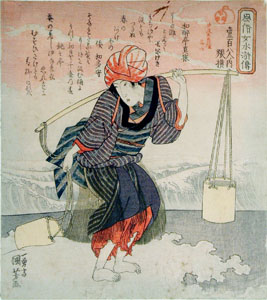![[Metroactive Arts]](/arts/gifs/art468.gif)
[ Arts Index | Silicon Valley | Metroactive Home | Archives ]
Craft As Art
The distinctions vanish at Palo Alto Art Center's show of Japanese art
By Michael S. Gant
WHILE THE CANTOR ARTS Center wrestles with the Chinese avant-garde (see article), the Palo Alto Art Center offers a fine complementary exhibit focusing on some traditional arts and crafts of Japan. Indeed, so exceptional are some of the objects on display that they obliterate any distinction between the functional and the aesthetic.
In the section of the tripartite show called "Moving Cabinetry," the center showcases superb Edo-era (1600s to the mid-1800s) examples of tansu, a term that encompasses a variety of cabinets and boxes made to be transported. These imminently practical storage units range from the simplicity of a peddler's wooden backpack to full-size chests mounted on large sturdy wheels. Full of a merchant's wares and papers, the latter were mobile storefronts. Richly layered with glowing patinas, cleverly constructed to contain multiple (and sometimes secret) drawers and often decorated with delicate hammered-metal hinges in the shape of flowers and other, these rolling containers proved to be an elegant solution to basic organizational problems.
"Spring Pool/Floating Sky" looks at how Japanese textile artists have used the special blue dye known as indigo. More than just a coloring agent, indigo has to be fermented in vats and tended by master artisans as if it were a fine aging wine. The 19th- and early-20th-century robes in the show are characterized by the purity and simplicity of their geometric designs. That style is built upon by modern textile artist Hiroyuki Shindo, who is represented by striking gauzy panels intensely colored by bold strokes of indigo that manage to be both calligraphic and sculptural at the same time.
The real treasures, however, are to be found in "The Gift," which brings together surimono prints from local museums and private donors. The multicolored woodcuts of courtesans dressed in brilliantly patterned kimonos and other denizens of the "floating world" known as Ukiyo-e are familiar and often reproduced. Less well-known as the surimono prints, which were privately issued in very limited numbers and used expensive techniques like subtle embossing and metal-flecked ink. The prints mark special occasions or illustrate poems, and the free-flowing calligraphy that accompanies and sometimes weaves around the figures and landscapes transforms syllables into a delicate rain of dancing ink swirls. Even after almost 200 years, these perfectly balanced images look as fresh as if they had just been pulled from the printer's blocks.
[ Silicon Valley | Metroactive Home | Archives ]
Copyright © Metro Publishing Inc. Metroactive is affiliated with the Boulevards Network.
For more information about the San Jose/Silicon Valley area, visit sanjose.com.
![]()

Water World: Kuniyoshi's surimono print features silver and gold-accented inks in its depiction of a woman gathering water at the beach.
Moving Cabinetry, Spring Pool/Floating Sky and The Gift shows through April 24 at the Palo Alto Art Center, 1313 Newell Rd., Palo Alto. Tuesday-Wednesday, Friday-Saturday, 10am-5pm, Thursday 10am-5pm, 7-9pm, Sunday 1-5pm. (650.329.2605)
Send a letter to the editor about this story to letters@metronews.com.
From the February 2-8, 2005 issue of Metro, Silicon Valley's Weekly Newspaper.